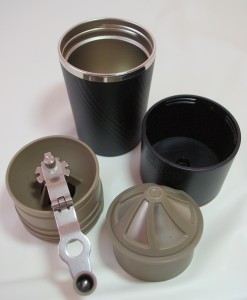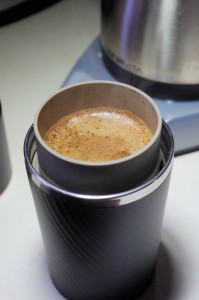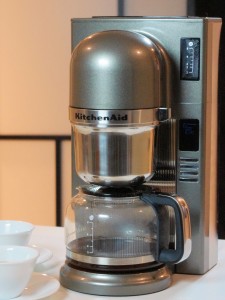

Cafflano Klassic coffeemaker
 We need a traveling coffeemaker. It may just be a romantic thought, but it’s as if coffee enthusiasts are always planning to travel and don’t wish to be way from a favorite method, or at least the ability to brew coffee at their same usual high standards. In this spirit is the Cafflano Klassic designed.
We need a traveling coffeemaker. It may just be a romantic thought, but it’s as if coffee enthusiasts are always planning to travel and don’t wish to be way from a favorite method, or at least the ability to brew coffee at their same usual high standards. In this spirit is the Cafflano Klassic designed.
There is also a need for an at-home or at-work one or two cup brewer. Every morning I brew a larger batch, but there are times during the day when one person wants a cup of coffee. I tend to make a cup at four, and I usually offer one to whomever I’m with. The Cafflano Klassic fills this bill nicely as well.
First, it is designed much like a thermos. It resembles the one you had as a kid to keep your milk cold. It completely screws together. You can easily place it in a suitcase, or toss it into the trunk of your car and know it will arrive still-assembled. Second, it is truly a coffee brewing system. It has everything you need to make coffee, except a water heater. More on that in a moment.
The operation is simple and intuitive. If you remove the top cap, that appears to be a water boiling vessel. Directly underneath is a hand-operated coffee grinder. Remove the grinder and you have a metal cone filter, and under that, is the coffee server. You literally make coffee by performing a striptease. Haha. Not really of course, but it is a nice, simple design.
Now, that top lid. While it looks like it is a kettle, you’d fill with water and pop into a microwave, its designer quickly corrected me when I asked about it. “While it is BPA Free, we would be concerned about possible molecular restructuring a microwave might perform and therefore recommend an external water kettle to heat your water. I respect their forthrightness and the purity in their view, but I must say the top cap even has what appears to be an exit hole to pour water over the grounds, but since it works against any claims of complete self-containment, I respect them for this.
 Note: I received a prototype. Its designers told me that the production model will be improved, if anything.
Note: I received a prototype. Its designers told me that the production model will be improved, if anything.
Operation: Simple, intuitive and hot
The Cafflano Klassic is intuitive. You operated it by taking it apart. You can place it on a scale, zero it, and add 20 grams of coffee beans. Grind them, remove the grinder and they’ll already be loaded into the screened drip filter, stored below the grinder. I feel this is a key to this brewer’s greatness, as it removes any complexity which could otherwise drive an end user to other less-capable methods.
Then, you simply add hot water in steps, just as you would in any drip maker. I tweaked the grinder until I got a six-minute start-to-finish contact time between the water and ground coffee. The closed design meant that finished coffee was quite hot, on par with that of an automatic drip maker, which is a good thing. I received an urgent phone call during one test; it was ten minutes before I got back to drink my coffee. It was still piping hot. The built in grinder is also an important part of the Cafflano Klassic’s gestalt. It would never occur to anyone to use pre-ground coffee. It’s assumed, which is as it should be.
Some may ask: “How do I set the grinder?” I simply moved it by notches until I found it took six minutes for the coffee to be brewed. This is the ideal contact time for a drip coffeemaker. If you like it a little less strong, move it another notch coarser. I like the notches. I have a Zassenhaus manual hand grinder and, while it does a nice job and its mechanism is fine, it has a free-floating adjustment screw. It drifts and for something as important as a grinder, I prefer a locking stop, such as the Cafflano Klassic features.
I used a recipe of 20 grams weighed coffee per 12 ounces of water. You will want to use a kettle, empty it and add the exact amount of water to boil, because you can’t see into the plastic reservoir.
 This is just a wonderful product. It does exactly what’s promised. It has a true, high-quality burr grinder. The torque, or balance between how often you must turn the grinder and its resistance while turning, is well proportioned, so grinding is less of a chore. The brewer’s design keeps the coffee enclosed and hot as it brews. The permanent filter is well made and filters all but a slight amount of very fine grounds, just enough to add a slight cloud to your coffee. I think most people will simply see it as a sign of thorough extraction and getting all the flavor in their cup. Fit and finish is first rate.
This is just a wonderful product. It does exactly what’s promised. It has a true, high-quality burr grinder. The torque, or balance between how often you must turn the grinder and its resistance while turning, is well proportioned, so grinding is less of a chore. The brewer’s design keeps the coffee enclosed and hot as it brews. The permanent filter is well made and filters all but a slight amount of very fine grounds, just enough to add a slight cloud to your coffee. I think most people will simply see it as a sign of thorough extraction and getting all the flavor in their cup. Fit and finish is first rate.
A couple of outstanding tastings:
Gorilla Coffee El Salvador La Esperanza – an old-growth bourbon coffee from one of the new hot NYC roasters, this coffee claims are cashew and red plum. I got a distinctively citrus note of some kind, but cashew was the furthest thing from my mind. However, the roast for a drip coffee was just about perfect. And the Cafflano Klassic just brought out the essence of that roast in spades.
Hapuna Espresso Blend – Surprise of the tasting, as I took the label too literally. This blend gave me one of my favorite taste experiences with this the Cafflano Klassic brewer. Kona, African and Indonesian beans roll into a delicious coffee cocktail.
Broadcast Coffee Roasters Guatemala La Hermosa – Honeysuckle, Milk Chocolate and Strawberry notes abound. The brewer just nails it. I got everything the roaster claimed it would have, and more.
Conclusion
This is the hardest kind of review. Everything works as planned. It’s a brewer that you will want to have for travel, for the afternoon one or two cups. Everything’s laid out so intuitively you won’t need to read the manual.
Highly recommended.
Pros –
• Easy to use
• Freshness built into product design
• Keeps coffee nice and hot until you use it
• Click stops on grinder (biggie)
• True high-quality burr grinder
• Permanent metal filter, high quality
• High overall build quality
• Easy carrying, quite portable
• Grinder torque smooth and easy to operate
• Simple to operate
Cons –
• Must be carefully cleaned afterwards
• Not truly independent – you need a third-party water heater
• Manufacturer made water boiler half from safe, microwaveable plastic, but still doesn’t recommend it.
• Need to measure water volume in advance of brewing. You can’t tell how much water is enough.
Neutral observations
• More silt than paper-filtered Aeropress – matter of opinion
KitchenAid’s Big Step!
 KitchenAid’s new 8-cup automatic drip Coffeemaker is proof that appliance manufacturers now take coffee making parameters as seriously as they do any culinary art. KitchenAid has long been a coffee innovator, with high build quality and within reasonable price points. This new model has literally been years in the making.
KitchenAid’s new 8-cup automatic drip Coffeemaker is proof that appliance manufacturers now take coffee making parameters as seriously as they do any culinary art. KitchenAid has long been a coffee innovator, with high build quality and within reasonable price points. This new model has literally been years in the making.
I visited them during summer 2012, during which time their four person design team held a therapy session, where I lay back and told them everything missing from most coffeemakers. Just kidding about that part, but suffice it to say, I left feeling unburdened and they went to work building it.
Sure enough, they brought it to this year’s CoffeeCon San Francisco and Los Angeles events. I recall making a beeline to taste a cup. It was good enough that I requested a model for my long-term at-home tests, from which I made review judgments.
This KitchenAid model has several important features:
• Pre-infusion stage. It dribbles a small amount of water, pauses to allow ultra fresh coffee grounds to get wet and exhale their carbon dioxide.
• Intermittent brewing throughout the brewing process, just like you instinctively do using a manual drip coffeemaker. We’ll talk more about this in in a moment.
• Two brewing temperatures. A higher one is just over 200°F, and optimized for lighter roasted (most Third Wave) coffees. The second, lower temperature setting stays under 200°F and is optimized for darker roast coffees. It’s up to you of course, as it’s so cutting edge that there’s hardly consensus on this subject. Suffice it to say, it’s amazing to see a big brand acknowledging the standards and then going a step further by offering you a choice of two brewing temperatures within those standards. Again, this is sophistication on par with manual brewing geeks.
• Perhaps the biggest news is that the KitchenAid meets SCAA (Specialty Coffee Association of America) brewing guidelines, which are stringent. This means a temperature spec (range: 196°-2015°F), within the given drip time spec of 4-6 minutes.
• Cup number setting. This at least promises to be an attempt to prefigure brewing algorithms so you and I don’t have to. More later, but this just might be their most important feature – if it does what it I think it promises.
First, let’s get this out of the way at the start – most so-called automatic drip brewers are one size brewers that are, by modern standards, not very automatic. If you make a full batch, they do well, maybe even very good, but most coffee enthusiasts eventually discover a manual coffee maker makes better coffee, since you have to figure out each parameter. But still, there’s a need for an automatic maker, because everyone, myself included has something else to do other than make coffee. It’s easy to operate. Just choose your cup setting. I had to get used to it, but the first thing you must do is select your desired cup batch size, but pressing plus/minus buttons. Then press whether you want light or dark roast (higher or lower brew temperature). Then hit brew and you’re ready in ten minutes, no matter what batch size.
How did it do in my tests?
Pre-infusion – The KitchenAid does really do this, but it’s still a best guess. As everyone who brews with manual drip brewers knows, this time varies depending upon how fresh your coffee is. KitchenAid designers chose a reasonable pause. It won’t please everyone, but in my tests, it did a good job of allowing most grounds to rise and fall, and then repeating this drip, pause, drip sequence throughout. Only at the 8-cup setting using extremely fresh roasted and freshly ground coffee did I get any foaming that left residue at the top of the brew basket (near showerhead). Most times it was not a problem.
Intermittent brewing – Part of the benefit of continuing to drip, pause and drip throughout the brewing is let all the water drip through before pouring more water onto the grounds. It seems to achieve a better, more thorough extraction. The KitchenAid did not disappoint. I’m sure there are some that will say their manual drip pours are better still, but for many, this brewer will deliver everything they want from their coffee.
Brewing temperature – Here KitchenAid has done itself proud. Its brewing temperature stability is as good or better than most manual drip, especially if you’re using a traditional kettle. If you’re using a kettle with settable temperature, the KitchenAid still matches or exceeds it, but the difference might be unnoticeable. Still, kudos for the two temperature choices and stability.
Cup setting – Many don’t realize that every automatic drip coffeemaker is optimized in contact time for one size batch. Larger batches will take too long, resulting in bitterness/excess strength; smaller batches mean faster (too fast) contact times and resulting weaker brew. This is simple math. If you baked a half batch of cookies and shortened or lengthened baking times, you wouldn’t expect them to taste right, would you? All drip makers, even manual ones have this challenge. KitchenAid seems to do some adjusting of the drip rate inside to accommodate the changing times, so it lessens it. I’d say they’ve make it work overall. The batches I made between four and eight cups were all between four and six minutes in overall contact time (this spec does not/should not count the time the water is heating with no contact). At the two cup setting, the contact time was not long enough. Keep in mind the cup quality may vary between 4 and 6 minutes contact time, but overall I was satisfied.
There are little tweaks you can try such as grinding a notch finer for fewer cups, or simply upping your grounds to water ratios a gram or two. I’ll leave it to others to explore these options. I settled on 6 cups for most of my tests over a month’s use and found it delivered excellent coffee at all settings between 5 and 8 cups, coffee on par overall with my manual drip brewers.
A couple of extra notations:
• The KitchenAid coffeemaker’s sound is quieter than most other automatic drip coffeemakers and its sound is subjectively nicer.
• KitchenAid is to be commended for offering detailed grounds to cup measuring recipes in their well-written instruction book.
• The water input at the KitchenAid’s top is too narrow for my tastes. I occasionally spilled water while filling it. Maybe it’s just me.
• I routinely filled the water tank exactly to the intended batch cups mark, and found the resulting brew on the carafe at brewing’s end was frequently less. I realize this may be caused by steam loss, but I found it works better to always overfill above the water mark.
Here are a few taste test highlights: I was fortunate to pick up a sample of Martin Diedrich’s Kean Coffee at CoffeeCon L.A. It was a slightly darker roast than most Third Wave roasts, and, (gasp) in my opinion, the better for it. It really shined, especially with using the lower (but still SCAA-approved) temperature setting. This kind of coffee really has that chocolate taste (cliché though it seems) and that temperature just seemed to highlight it.
Another treat was Counter Culture’s latest Ethoipian in a new package. This one really called for the higher temperature, but fully matched my expectations, with a fruitiness and acidity this coffee brewer brought forth in all its glory.
A surprise hit of CoffeeCon LA’s roasts was Temple Coffee’s Panama Geisha. Oh my Lord! What a coffee!! I did two batches concurrently. It was so good I went past my limit. The high temperature was my preference, but it did splendidly (albeit differently) in each. Note: I found a perfect formula for me was to make six cups, using 50 weighed grams of beans, medium-fine grind. The slightly less than full batch allowed even the freshest coffees to brew properly, and gave us a perfect way for Pat, I and a friend each have a couple of cups each.
The KitchenAid 8-cup is highly recommended.
No Results Found
The page you requested could not be found. Try refining your search, or use the navigation above to locate the post.

